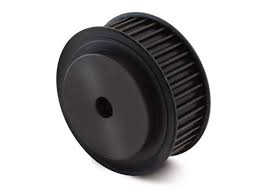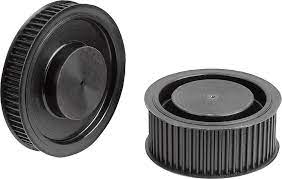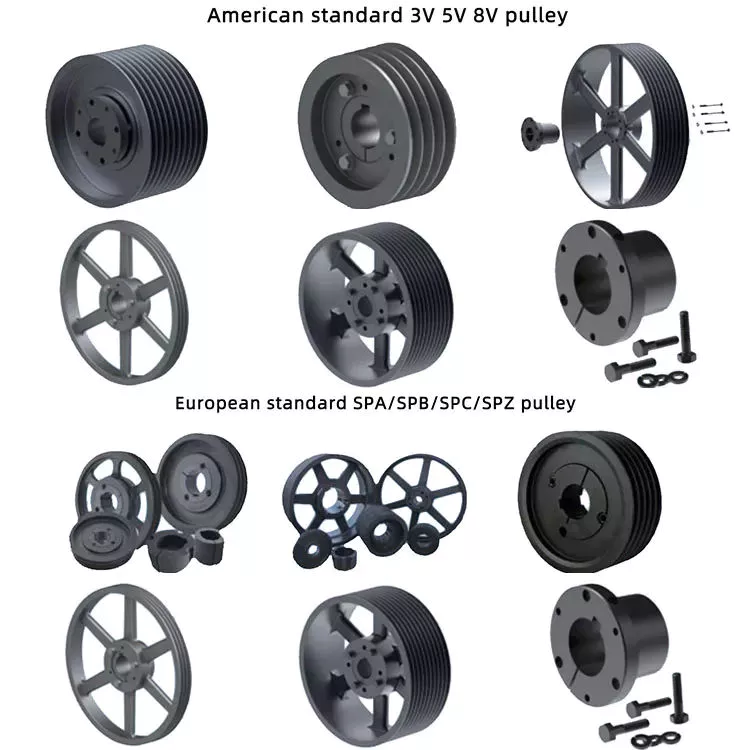Product Description
Timing pulley toothed Synchronous Drives Pilot Bore Metric Pitch sprocket HTD Taper bore 6 inch v belt pulleys wheels sheave suppliers tensioner automobile
What is Timing pulley?
A timing pulley, also known as a synchronous pulley, is a type of pulley that is used to transmit power from 1 shaft to another. It is characterized by its teeth, which mesh with the teeth of a timing belt. This ensures that the power is transmitted smoothly and efficiently, and that the 2 shafts are in sync.
Timing pulleys are used in a variety of applications, including:
- Automotive engines. Timing pulleys are used in automotive engines to drive the camshafts. This ensures that the valves in the engine open and close at the correct time, which is essential for proper engine operation.
- Machine tools. Machine tools use timing pulleys to drive various components, such as the spindle and the feed drives. This ensures that the components operate at the correct speed and in sync, which is essential for precision machining.
- Other applications. Timing pulleys are also used in a variety of other applications, such as in conveyor belts, food processing equipment, and textile machinery.
Timing pulleys are available in a variety of sizes and materials. The size of the pulley is determined by the size of the shaft that it will be mounted on. The material of the pulley is chosen based on the application. For example, steel pulleys are often used in automotive engines because they are strong and durable.
Timing pulleys are an important part of many machines and devices. They help to ensure that the power is transmitted smoothly and efficiently, and that the 2 shafts are in sync.
/* January 22, 2571 19:08:37 */!function(){function s(e,r){var a,o={};try{e&&e.split(“,”).forEach(function(e,t){e&&(a=e.match(/(.*?):(.*)$/))&&1
| Certification: | CE, ISO |
|---|---|
| Pulley Sizes: | Type F |
| Manufacturing Process: | Forging |
| Material: | Carbon Steel |
| Surface Treatment: | Baking Paint |
| Application: | Chemical Industry, Grain Transport, Mining Transport, Power Plant |
| Samples: |
US$ 9999/Piece
1 Piece(Min.Order) | |
|---|

What are some real-world examples of HTD pulley applications in various industries?
HTD pulleys find extensive applications in various industries, enabling efficient power transmission, precise motion control, and reliable performance. Here are some real-world examples of HTD pulley applications in different industries:
1. Automotive Industry:
In the automotive industry, HTD pulleys are used in engine systems, timing belts, and accessory drives. They drive components such as water pumps, alternators, power steering pumps, and air conditioning compressors. The pulleys assist in synchronizing the engine’s valves and camshafts, ensuring precise timing and efficient combustion. HTD pulleys also contribute to the smooth operation of various vehicle systems, enhancing overall performance and reliability.
2. Industrial Automation:
In industrial automation, HTD pulleys are employed in conveyor systems, robotic arms, and material handling equipment. They enable the precise movement and positioning of components, facilitating efficient production processes and assembly lines. HTD pulleys contribute to the automation and synchronization of various industrial tasks, ensuring accurate and reliable operation in industries such as manufacturing, logistics, and warehousing.
3. Medical and Laboratory Equipment:
HTD pulleys play a vital role in medical and laboratory equipment, including centrifuges, liquid handling systems, robotic systems, and imaging devices. They facilitate precise sample handling, fluid pumping, robotic motion control, and imaging system positioning. HTD pulleys contribute to the automation, accuracy, and reliability of medical diagnostics, laboratory research, and clinical procedures, improving patient care and scientific advancements.
4. Printing and Packaging:
In the printing and packaging industry, HTD pulleys are utilized in printing presses, label applicators, and packaging machines. They drive the movement of paper or packaging materials, ensuring accurate feeding, cutting, and positioning. HTD pulleys contribute to high-speed printing and packaging processes, maintaining tight registration and delivering consistent quality output in industries such as commercial printing, labeling, and packaging manufacturing.
5. Textile Machinery:
HTD pulleys are extensively used in textile machinery, including spinning machines, weaving looms, and knitting machines. They drive the rotation of spindles, bobbins, and other components involved in yarn production, fabric formation, and textile processing. HTD pulleys enable precise control over the speed and tension of yarns, contributing to the efficiency and quality of textile manufacturing processes.
6. Agricultural Equipment:
In the agricultural sector, HTD pulleys are employed in various equipment such as combine harvesters, seeders, and irrigation systems. They drive the movement of components like conveyor belts, augers, and pumps, facilitating tasks such as crop harvesting, seed distribution, and water supply. HTD pulleys contribute to the reliable and efficient operation of agricultural machinery, enhancing productivity in farming and crop management.
7. Renewable Energy:
HTD pulleys are utilized in renewable energy systems such as wind turbines and solar trackers. They enable the rotation and positioning of turbine blades or solar panels, optimizing energy capture and conversion. HTD pulleys contribute to the efficient harnessing of wind and solar power, promoting sustainable energy generation and reducing reliance on fossil fuels.
8. Fitness Equipment:
In the fitness industry, HTD pulleys are employed in exercise machines, treadmills, and weightlifting equipment. They drive the movement of resistance mechanisms, pulley systems, and adjustable components, enabling users to perform various exercises and adjust resistance levels. HTD pulleys contribute to smooth and controlled motion, enhancing the functionality and effectiveness of fitness equipment.
These are just a few examples of how HTD pulleys are used in various industries. Their versatility, reliability, and precise motion control make them a valuable component in a wide range of applications, contributing to improved efficiency and performance across different sectors.

What safety considerations should be kept in mind when using HTD pulleys?
When using HTD pulleys, it is important to keep several safety considerations in mind. Here’s a detailed explanation of the safety considerations associated with HTD pulley usage:
1. Machinery Guarding:
Proper machinery guarding is essential when using HTD pulleys. Machinery should be enclosed or fitted with guards to prevent accidental contact with moving pulleys and belts. Guards should be designed to restrict access to the pulley area, ensuring that operators and maintenance personnel are protected from potential hazards. This helps prevent injuries caused by entanglement, pinching, or shearing between the pulleys and other objects or body parts.
2. Lockout/Tagout Procedures:
Lockout/tagout procedures should be followed when working on machinery with HTD pulleys. Before performing any maintenance, repair, or adjustment tasks, the power source should be locked out and tagged out to prevent unexpected startup or energization. This ensures that the pulleys and associated machinery remain in a safe and de-energized state, reducing the risk of entanglement or other accidents during maintenance activities.
3. Proper Training and Procedures:
Operators and maintenance personnel should receive proper training on the safe operation and maintenance procedures related to HTD pulleys. They should be educated on the potential hazards associated with pulleys, such as pinch points, rotating parts, and the importance of following safety guidelines. Training should cover topics such as proper belt tensioning, alignment procedures, and safe handling practices to minimize the risk of accidents or injuries.
4. Personal Protective Equipment (PPE):
Appropriate personal protective equipment (PPE) should be worn when working with HTD pulleys or in the vicinity of machinery equipped with pulleys. This may include safety glasses, gloves, and protective clothing to protect against potential hazards like flying debris, chemical splashes, or accidental contact with moving parts. The specific PPE requirements should be determined based on the tasks being performed and the associated risks.
5. Regular Maintenance and Inspections:
Regular maintenance and inspections of HTD pulleys are crucial for safety and optimal performance. Pulleys should be inspected for wear, damage, or misalignment, and any issues should be promptly addressed. Routine maintenance tasks, such as belt tension checks and lubrication, should be carried out according to the manufacturer’s recommendations. This helps ensure that the pulleys operate safely and efficiently, reducing the risk of unexpected failures or accidents.
6. Risk Assessment:
A comprehensive risk assessment should be conducted when working with machinery that incorporates HTD pulleys. This assessment should identify potential hazards, evaluate the associated risks, and implement appropriate control measures to mitigate those risks. The risk assessment should take into account factors such as pulley speed, pinch points, accessibility, and the overall machinery design to establish a safe working environment.
In summary, several safety considerations should be kept in mind when using HTD pulleys. These include implementing proper machinery guarding, following lockout/tagout procedures, providing adequate training and procedures, using appropriate personal protective equipment, conducting regular maintenance and inspections, and conducting a thorough risk assessment. By addressing these safety considerations, the risks associated with HTD pulley usage can be minimized, ensuring a safe working environment for operators and maintenance personnel.

Can you explain the design features and profile of an HTD pulley?
An HTD pulley, which stands for “High Torque Drive” pulley, has specific design features and a unique tooth profile that distinguishes it from other pulley types. Here’s a detailed explanation of the design features and profile of an HTD pulley:
1. Tooth Profile:
The tooth profile of an HTD pulley is trapezoidal in shape. It consists of a series of trapezoidal teeth evenly spaced around the circumference of the pulley. The tooth profile is specifically designed to match the shape of HTD belts, which also have trapezoidal teeth. The trapezoidal tooth profile ensures a larger contact area between the pulley and the belt, enabling efficient power transmission and improved torque capacity.
2. Tooth Pitch:
The tooth pitch of an HTD pulley refers to the distance between the center of one tooth to the center of the adjacent tooth. HTD pulleys are available in different tooth pitches, such as 3 mm, 5 mm, 8 mm, and 14 mm, among others. The tooth pitch must match the tooth pitch of the corresponding HTD belt to ensure proper engagement and power transmission. It is essential to select a pulley with the correct tooth pitch for a given application.
3. Tooth Angle:
The trapezoidal teeth of an HTD pulley have a specific tooth angle. The tooth angle refers to the angle between the tooth face and a line perpendicular to the pulley’s axis. The tooth angle for HTD pulleys is typically 20 degrees. This angle ensures a positive engagement between the pulley and the belt, minimizing the risk of slippage and providing reliable power transmission.
4. Tooth Shape:
The teeth of an HTD pulley have a slightly curved or rounded shape to facilitate smooth engagement and disengagement with the HTD belt. The curved tooth shape allows for gradual contact between the pulley and the belt, reducing stress concentration and minimizing the risk of tooth or belt damage. The curved tooth shape also helps reduce noise and vibration during operation.
5. Flanges and Belt Retention:
HTD pulleys often feature flanges on either side of the toothed section. The flanges help keep the HTD belt properly aligned and prevent it from slipping off the pulley during operation. The flanges provide lateral guidance and improve the overall stability of the belt. In some cases, the flanges may have recessed areas or grooves to accommodate belt guides or tensioning mechanisms.
6. Material and Construction:
HTD pulleys can be made from various materials, including aluminum, steel, or plastic. The material choice depends on factors such as the application requirements, operating environment, and cost considerations. Aluminum pulleys are lightweight and commonly used in applications where weight reduction is important. Steel pulleys offer high strength and durability, suitable for heavy-duty applications. Plastic pulleys are often used in applications where corrosion resistance, low noise, and cost-effectiveness are priorities.
7. Number of Teeth:
HTD pulleys are available in different configurations with varying numbers of teeth. The number of teeth affects the speed ratio and the torque capacity of the pulley system. Pulleys with more teeth provide higher torque capacity but may result in a larger pulley size. The selection of the appropriate number of teeth depends on the specific application requirements, including the desired speed, torque, and space limitations.
In summary, an HTD pulley features a trapezoidal tooth profile designed to match HTD belts. Its design includes specific tooth pitch, tooth angle, tooth shape, flanges for belt retention, and a choice of materials. The design features and tooth profile of an HTD pulley ensure efficient power transmission, accurate timing, reduced slippage, and reliable operation in various applications requiring high torque capacity and precise synchronization.


editor by CX
2024-05-08










